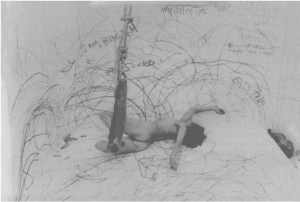“Even to an entirely female audience, female performers who expose their
breasts will appear more “naked” than male performers who expose their bare chests” ((Toepfer, Karl (1996) ‘Nudity and Textuality in Postmodern Performance’, Performing Arts Journal, XVIII (3) September: pp. 76-91, p. 76.)).
Nudity in performance exploits the performers’ innate position of vulnerability, exposing everything, giving them nothing to hide and nothing to act behind. Leaving all inhibitions at the door, revealing and performing the most intimate parts of yourself to strangers. Although nudity is becoming more common place within the theatre, with the mantra “bums on seats and bums on stage” ((Masters, Tim (2012) ‘Actors reveal challenges of stage nudity’, BBC News, Online: http://www.bbc.co.uk/news/entertainment-arts-2165403 (accessed 06 March 2013).)), often filling the auditorium and having a greater pull of an audience. Nudity no longer “throw[s] an uneasy frost across an auditorium” ((Masters, Tim (2012) ‘Actors reveal challenges of stage nudity’, BBC News, Online: http://www.bbc.co.uk/news/entertainment-arts-2165403 (accessed 06 March 2013). )) when done with sensitivity and distance. However, what would happen if we brought this nudity closer the audience, and placed it in such a space in which they couldn’t escape?
Having a narrative played to an audience member, leading and coaxing their reactions, and encouraging them to interact with a naked performer changes the dynamics of a performance beyond recognition as the performance is no longer ‘safe’. Being ‘naked’ is accepted, but to be naked and chained. Or bound. Gagged? To have no voice or identity, and just to be a naked object. An object to be possessed and owned could be highly unnerving to the audience.

Carolee Schneemann (1996),’ Up To and Including Her Limits’ photo: Courtesy Henrik Gaard in Karl Toepfer ‘Nudity and Textuality in Postmodern Performance’, Performing Arts Journal, XVIII (3) September: pp. 76-91, p. 81.
“This potential of the nude performing body to shock, incite, frighten, disgust, or otherwise produce intense emotional turbulence” ((Toepfer, Karl (1996) ‘Nudity and Textuality in Postmodern Performance’, Performing Arts Journal, XVIII (3) September: pp. 76-91, p. 77. )) can be considered as pushing the boundaries of performance and what we call art. Showing a naked woman in a compromising position will shock any audience member who views the piece, making them question what they deem acceptable as ‘performance’. For the woman to show herself, and not a character, is a brave thing to do. No aesthetics of performance to hide behind, no fake identity, no alternate reality.
Being naked, and exposed is a challenge.
To let others see you in such a demeaning position. Those who are your elders, superiors, friends, peers and strangers. Hiding behind nothing but handcuffs and a thin layer of baby oil.
I am not a professional performance artist, this isn’t my job. Although…for this performance, I guess I am. Trying to forget the pre-established relationships is the hardest block I have come across as “in the act of stripping, actor and character become indistinguishable: the flesh that is exposed by the character is the actor’s flesh” ((Scolnicov, Hanna (2010) ‘Stripping as Gesture’, ASSAPH: Section C: Studies in the Theatre, XXIV, pp. 139-152, p. 139.)).
“Stripping is a radical and unique gesture because it collapses the gap between the actor and the character” ((Scolnicov, Hanna (2010) ‘Stripping as Gesture’, ASSAPH: Section C: Studies in the Theatre, XXIV, pp. 139-152, p. 150.))
The reactions.
Forcing the audience to share something intimate about themselves by them possibly showing their raw reactions . Personally, I find this thought comforting. Knowing that the audience members are also ‘stripping bare’ while we were literally stripped bare offers some sort of comfort – the audience is also being placed in a slightly compromising position, while at the same time, witnessing us in, and simultaneously adding to our established comprised position.
“Detached from the desirability of bodies, mythic nudity invites the spectator to emulate without “anxiety,” the naked identity of the performer: all bodies become “the same,” since it is the condition of nakedness, not the condition of bodies” ((Toepfer, Karl (1996) ‘Nudity and Textuality in Postmodern Performance’, Performing Arts Journal, XVIII (3) September: pp. 76-91, p. 79.)).
Toepfer argues that “all bodies become “the same,”” ((Toepfer, Karl (1996) ‘Nudity and Textuality in Postmodern Performance’, Performing Arts Journal, XVIII (3) September: pp. 76-91, p. 79.)) due to the exposure, then our naked bodies might strike a chord with the audience members.
Getting naked in performance is not a new idea, or even so much a radical one for modern audiences. But for me, personally, it “is a radical and even violent theatrical gesture” ((Scolnicov, Hanna (2010) ‘Stripping as Gesture’, ASSAPH: Section C: Studies in the Theatre, XXIV, pp. 139-152, p. 141.)). By doing this performance, and getting over personal reservations and boundaries has made me a stronger performer. And, arguably, person. To know I have the power to push past pre-set social and personal restraints is liberating. Personal reservations? Personal revelations is perhaps more fitting.